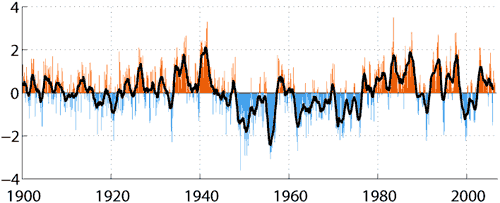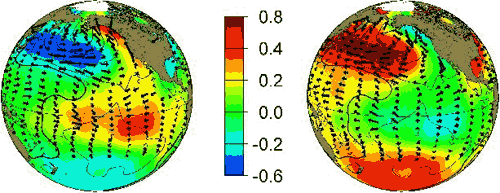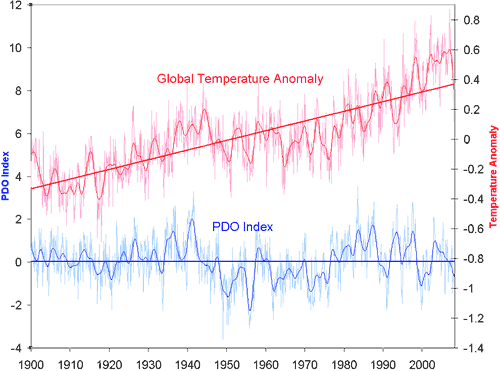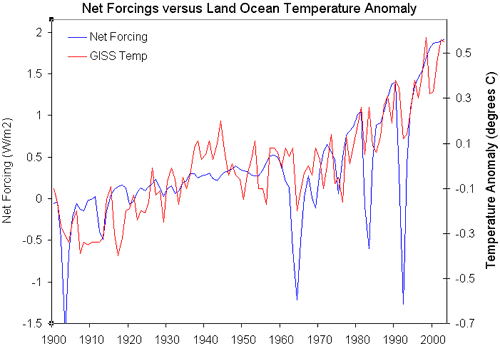Is Pacific Decadal Oscillation the Smoking Gun?
Posted on 3 May 2008 by John Cross
The blogosphere is abuzz with the news that the Pacific Decadal Oscillation is reverting to a cool phase. Hot on the heels of this bombshell, a new climate model predicts a cooling North Atlantic Ocean will slow down global warming. This has led to speculation that man-made global warming is no match for natural cycles or even that Pacific Decadal Oscillation is responsible for most of the climate change over the past century including the warming since the mid-70's.
What is Pacific Decadal Oscillation?
The PDO is a climate phenomena found primarily in the North Pacific (as opposed to El Niño which affects mostly the tropical Pacific). It has two phases that it typically alternates between; usually staying in one phase for a significant period of time (as little as 10 and as much as 40 years). However, it's not uncommon for these long periods to be broken by intervals when it switches phases for anything between 1 and 5 years. The phases of the PDO have been called warm phases (positive values) or cool phases (negative values).

Figure 1: Monthly values for PDO index: 1900 to May 2006. Figure source: Climate Impacts Group
So the first lesson of PDOs is that while we talk about a 20 to 30 year period, it is not very clear cut at all. In fact, an analysis of the frequency of the events does not produce much in the way of a firm period. Incidentally back in 1999 it was predicted that we were entering a cool phase.
The second lesson of PDOs is that while we talk about warm phases and cool phases these are more names than physical descriptions. As seen in Figure 2, a cool phase PDO is associated with cool sea surface temperatures along the Pacific coast of North America, but the center of the North Pacific ocean is still quite warm. Consequently it would appear that there is nothing fundamental about a PDO that would cause significant changes to global temperatures.

Figure 2: PDO warm phase (left) and cool phase (right). Image courtesy of JISAO.
Nevertheless, climate is always full of surprises and to be complete we should look at how the PDO's change of phase coincide with a change in climate trends? In 1905, PDO switched to a warm phase as global warming began. In 1946, PDO switched to a cool phase as temperatures cool mid-century. In 1977, PDO switched to a warm phase around the same time as the modern global warming period. Is PDO the smoking gun?

Figure 3: Monthly PDO index (blue) versus monthly global land ocean temperature anomanly (red). Smoothed data and trend lines are added.
While PDO does have some degree of correlation with short term variations in global temperature, the striking feature of Figure 3 is the contrast in trends between PDO and global temperature. Obviously the PDO as an oscillation between positive and negative values shows no long term trend. In contrast, temperature displays a long term warming trend. When the PDO last switched to a cool phase, global temperatures were about 0.4C cooler than currently.
The long term warming trend indicates the total energy in the Earth's climate system is increasing. This is due to an energy imbalance - more energy is coming in than is going out (Hansen 2005). Various factors affect the Earth's energy balance. A brightening sun increases inbound energy. Atmospheric aerosols reflect sunlight, decreasing inbound energy. Greenhouse gases absorb outgoing longwave radiation, reducing the amount of outgoing energy.
The total energy imbalance is expressed as net forcing, the sum of all the various forcings (eg - solar, aerosols, greenhouse gases, etc). Figure 4 compares net forcing to global temperature over the 20th century:

Figure 4: Net forcing (Blue - NASA GISS) versus global land ocean temperature anomaly (Red - GISS Temp).
When all forcings are included, net forcing shows good correlation with global temperatures. There is no single smoking gun. As our climate continues to absorb more energy than it emits, we can expect the long term warming trend to continue with short term fluctuations superimposed. This is the point of Keenlyside 2008 and is echoed by the Hadley Centre who predicted internal variability will partially offset the anthropogenic global warming signal for the next few years (Smith 2007).
Both predictions come from climate models seeking to incorporate ocean dynamics (I'm surprised noone has coined the term GCM 2.0 yet). These new models predict that while warming will slow over the next few years due to internal variability, the warming trend will resume in the long term.
This post was co-authored by John Cross and John Cook.































 Arguments
Arguments























 0
0  0
0






Comments